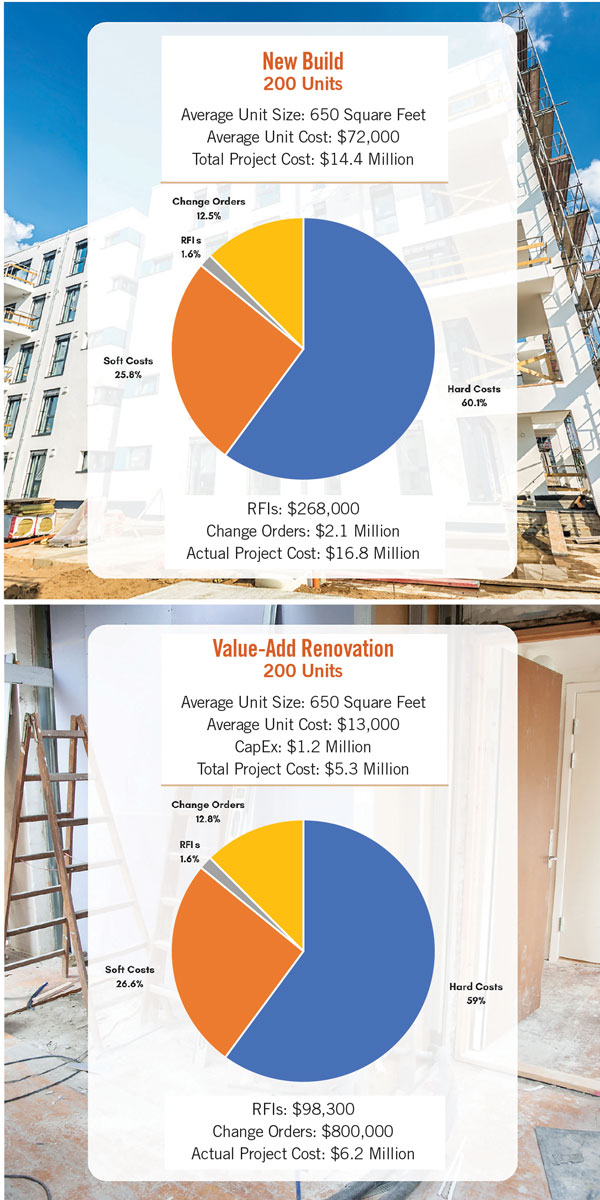How RFIs and Change Orders Disrupt Multifamily Development Projects

Early planning and collaboration can help avoid costly do-overs later.
Complete construction plans for multifamily new construction and renovations consist of multiple sheets. These can include architectural, mechanical, electrical, civil, structural and possibly more depending on the complexity of the project. With the cost of hiring an architect typically accounting for about 10% to 15% of the entire construction and development budget on a multifamily project, it is imperative to make the most out of that investment. To ensure these drawings are accurate, comprehensive and complete, owners, architects and contractors must work together as a team, starting with the project design.
According to the Construction Industry Institute, construction firms spend an estimated $15 billion annually performing rework on projects due to inaccuracies in the initial drawings, failure to distribute new versions of drawings to subcontractors, and discrepancies between builders and architects. When a complex project is drafted by an architect who is inexperienced in multifamily construction, and it is done without assistance from contractors or input from stakeholders, the results can be disastrous to budgets and timelines.
If contractors receive incorrect or incomplete drawings, owners can expect incorrect or incomplete bids from the start. That will be followed by a steady stream of requests for information (RFIs) and change orders throughout the project. RFIs and change orders lead to schedule delays, changes in plans and increased risk for the lender.
Do the Work Early On
“Spending additional time at the front end of a project can go a long way toward minimizing change orders over the long haul,” says Colin McCarthy, a principal with Lanak & Hanna PC, a California-based law firm that specializes in construction law. He recommends that owners “use this time to look critically at the work, drawings and details, to ensure that the contractor’s bid clearly includes or excludes certain items.”
After sampling 1,362 projects of all kinds around the world between 2001 and 2012, Navigant Consulting discovered that reviewing and responding to each individual RFI cost a construction firm an average of $1,080, while the collective cost to the project could set a firm back $859,680. Furthermore, researchers in India have found that change order costs typically amount to 10% to 15% of the contract value on major projects.
The charts below illustrate the financial impact of RFIs and change orders on two hypothetical multifamily projects. One is for a new build and another is for a value-add renovation.
Among the top contributing factors to change orders are instructions (or lack of instructions) in the plans and specifications that, if followed by the contractor, would require additional costs for replacement or corrections, or result in a construction failure. These include incomplete designs, poor design coordination and specifications issues, all of which can be avoided at the design stage.

These charts show how RFIs and change orders affect two examples of multifamily projects — a new build (top) and a value-add renovation. Kapella Group
A research paper published in 2016 by the International Journal of Scientific & Engineering Research found that “the time it takes to produce a quality set of design documents is clearly not enough.” The study notes that the major concern “should not be time but rather the quality of the design.”
What’s the Solution?
There’s a popular phrase, “measure twice, cut once.” Used in the literal sense by contractors, it applies to the entire multifamily development process. A broad range of research confirms that spending more time and money upfront to ensure accurate, comprehensive and complete construction drawings is key to avoiding greater costs, conflicts and delays during the build phase. Including contractors in the design and scope development phase requires more time going over inaccuracies, deficiencies and conflicting information, but in the long run it can pay off in a big way. It also allows all parties to set expectations and guidelines for clear communication before bidding and construction commence.
“Having the builders on board during the early stages of the design will have a positive impact on the project as a whole,” said Aki Merced with BIMSmith in a May 2019 blog post on the company’s website. “Both architects and contractors can work in identifying the goals of the project, the specifications of the structure, and the subsequent costs. If there are flaws in the plan, the contractor can easily point them out before they can become bigger problems in the future.”
Effective communication and a collaborative approach between architects and contractors during the design phase eliminates problems such as infeasible designs, improper material selection or inaccurate cost estimating. It maximizes the expertise and experience of both architects and contractors to determine the best construction methods and project phasing. It can also greatly reduce the amount of RFIs, change orders, schedule delays and budget overrides.
Erik Good, a senior project manager with Kapella Group, says the best advice he can give any developer is to bring the team in early. A great team that will save money should include the general contractor, architect, property management company and owner.
“You create a team that is working together to maximize quality, efficiency and constructability, while simultaneously accomplishing the developer’s budget,” he said. “By creating an environment where everyone is working together instead of in isolation, you eliminate inefficiencies and generate clarity. This kind of teamwork between the architects, contractors and owners creates a productive environment and a more profitable outcome.”
Denis Koval is the CEO of Kapella Group in Centennial, Colorado.




